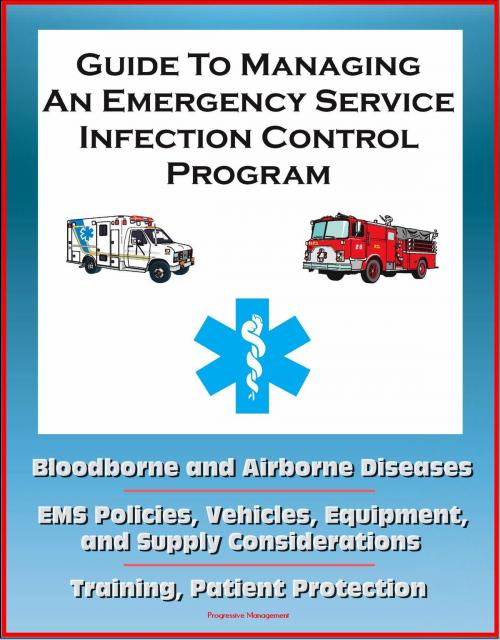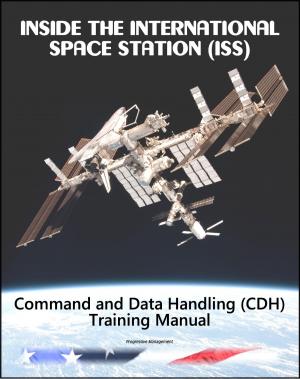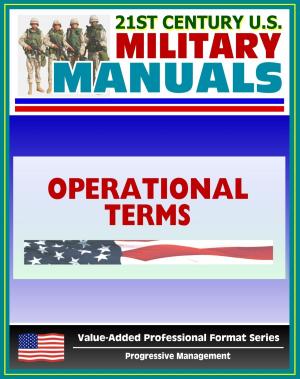Guide to Managing an Emergency Service Infection Control Program: Bloodborne and Airborne Diseases, EMS Policies, Vehicles, Equipment, and Supply Considerations, Training, Patient Protection
Nonfiction, Health & Well Being, Health, Ailments & Diseases, Contagious, Medical, Allied Health Services, Emergency Medical Services| Author: | Progressive Management | ISBN: | 9781476257303 |
| Publisher: | Progressive Management | Publication: | August 15, 2012 |
| Imprint: | Smashwords Edition | Language: | English |
| Author: | Progressive Management |
| ISBN: | 9781476257303 |
| Publisher: | Progressive Management |
| Publication: | August 15, 2012 |
| Imprint: | Smashwords Edition |
| Language: | English |
Since infection control requirements vary by agency type, local regulations, department size, etc., emergency response organizations cannot simply adopt a generic infection control program as their program. Therefore, this Guide is designed as a resource to help emergency response organizations tailor the requirements identified in regulations and standards to their own unique situations.
The structure of the Guide facilitates its use for different purposes. The first section, Overview of Infection Control contains two chapters.
• Chapter 1: Technical Background summarizes basic terms and concepts, and describes the risks associated with various communicable diseases particularly relevant to emergency services.
• Chapter 2: Laws and Regulations summarizes applicable laws, regulations, and standards.
The second section, Components of an Infection Control Program, covers the aspects of an infection control program that organizations need to address. These components include risk management, training and education, health maintenance, roles and responsibilities of department personnel, policies and procedures, standard operating procedures, and interactions with other departments.
The third section, Vehicles, Equipment, and Supply Considerations, addresses issues related to vehicle design, decontamination of disposable and non-disposable equipment, equipment advances (including needleless systems), and considerations related to clothing/linen and volunteers responding from and returning to home or the primary workplace.
The fourth section, Facilities Considerations, discusses infection control in relation to the various functioning areas of emergency services facilities. The fifth section, Assessing Effectiveness, provides a description of the evaluation process. A step-by-step approach for developing performance standards and compliance (evaluation criteria) for measuring effectiveness is described. Other aspects addressed include information management and program revision. The final section, Special Situations, provides a brief overview of infection control practices in the training environment and as they relate to protecting the patient.
Contents: INTRODUCTION * SECTION 1: OVERVIEW OF INFECTION CONTROL * Chapter One: Technical Background * Introduction to Infection Control * Basic Concepts * Assessing Risk Potential * Bloodborne Diseases * Airborne Diseases * Infection Control Techniques * Summary * Chapter Two: Laws, Regulations, and Standards * Public Law * OSHA Regulations * National Fire Protection Association (NFPA) * Centers for Disease Control and Prevention * Summary * SECTION 2: COMPONENTS OF AN INFECTION CONTROL PROGRAM * Risk Management * Risk Management Model * Training and Education * Members * Health Maintenance * Roles and Responsibilities * Policies and Procedures * Exposure Control Plan * Standard Operating Procedures * Interactions with Other Departments * SECTION 3: VEHICLES, EQUIPMENT, AND SUPPLY CONSIDERATIONS * Vehicles * Personal Protective Equipment * Equipment and Supplies * Equipment Advances * Other Considerations * Summary * SECTION 4: FACILITIES CONSIDERATIONS * The Need for Facility Safety * Facility Issues * Summary * SECTION 5: ASSESSING EFFECTIVENESS: THE EVALUATION PROCESS * Overview * Assessing Effectiveness * Information Management * Program Revision * Action Plan * Summary * SECTION 6: SPECIAL SITUATIONS * Overview * The Training Environment * Protecting the Patient * Summary * BIBLIOGRAPHY * APPENDICES * Appendix A: Glossary of Common Terms * Appendix B: Laws, Regulations, and Standards * Appendix C: Sources of Additional Information
Since infection control requirements vary by agency type, local regulations, department size, etc., emergency response organizations cannot simply adopt a generic infection control program as their program. Therefore, this Guide is designed as a resource to help emergency response organizations tailor the requirements identified in regulations and standards to their own unique situations.
The structure of the Guide facilitates its use for different purposes. The first section, Overview of Infection Control contains two chapters.
• Chapter 1: Technical Background summarizes basic terms and concepts, and describes the risks associated with various communicable diseases particularly relevant to emergency services.
• Chapter 2: Laws and Regulations summarizes applicable laws, regulations, and standards.
The second section, Components of an Infection Control Program, covers the aspects of an infection control program that organizations need to address. These components include risk management, training and education, health maintenance, roles and responsibilities of department personnel, policies and procedures, standard operating procedures, and interactions with other departments.
The third section, Vehicles, Equipment, and Supply Considerations, addresses issues related to vehicle design, decontamination of disposable and non-disposable equipment, equipment advances (including needleless systems), and considerations related to clothing/linen and volunteers responding from and returning to home or the primary workplace.
The fourth section, Facilities Considerations, discusses infection control in relation to the various functioning areas of emergency services facilities. The fifth section, Assessing Effectiveness, provides a description of the evaluation process. A step-by-step approach for developing performance standards and compliance (evaluation criteria) for measuring effectiveness is described. Other aspects addressed include information management and program revision. The final section, Special Situations, provides a brief overview of infection control practices in the training environment and as they relate to protecting the patient.
Contents: INTRODUCTION * SECTION 1: OVERVIEW OF INFECTION CONTROL * Chapter One: Technical Background * Introduction to Infection Control * Basic Concepts * Assessing Risk Potential * Bloodborne Diseases * Airborne Diseases * Infection Control Techniques * Summary * Chapter Two: Laws, Regulations, and Standards * Public Law * OSHA Regulations * National Fire Protection Association (NFPA) * Centers for Disease Control and Prevention * Summary * SECTION 2: COMPONENTS OF AN INFECTION CONTROL PROGRAM * Risk Management * Risk Management Model * Training and Education * Members * Health Maintenance * Roles and Responsibilities * Policies and Procedures * Exposure Control Plan * Standard Operating Procedures * Interactions with Other Departments * SECTION 3: VEHICLES, EQUIPMENT, AND SUPPLY CONSIDERATIONS * Vehicles * Personal Protective Equipment * Equipment and Supplies * Equipment Advances * Other Considerations * Summary * SECTION 4: FACILITIES CONSIDERATIONS * The Need for Facility Safety * Facility Issues * Summary * SECTION 5: ASSESSING EFFECTIVENESS: THE EVALUATION PROCESS * Overview * Assessing Effectiveness * Information Management * Program Revision * Action Plan * Summary * SECTION 6: SPECIAL SITUATIONS * Overview * The Training Environment * Protecting the Patient * Summary * BIBLIOGRAPHY * APPENDICES * Appendix A: Glossary of Common Terms * Appendix B: Laws, Regulations, and Standards * Appendix C: Sources of Additional Information















